Building a Cohesive Collection: 7 Tips for the Art of Curating Eclectic Thrift Store Treasures
I’ve learned that curating thrift treasures starts with defining your aesthetic—three keywords and a phone mood board before you shop. I establish one unifying element (color palette, era, or theme) and stick to the 80/20 rule: 80% neutrals, 20% bold finds. I practice the walk-away test, asking if I’d live with each piece for five years. Mixing eras works when there’s intentional contrast through shared colors or scales, and I rotate displays seasonally to keep things fresh. The details below will show you exactly how I pull it all together.
Design Highlights
- Define three aesthetic keywords and a unifying element like color palette or frame style before shopping to prevent impulse purchases.
- Apply the 80/20 rule by building an 80% neutral foundation, then accenting with 20% bold thrift finds as anchors.
- Create visual rhythm through recurring colors, shapes, materials, or themes across pieces rather than matching items identically.
- Mix eras intentionally by pairing contrasting styles that connect through shared color, scale, or subject matter elements.
- Practice the walk-away test and edit ruthlessly by rotating displays seasonally and donating pieces unused for two years.
Define Your Core Aesthetic Before You Start Shopping
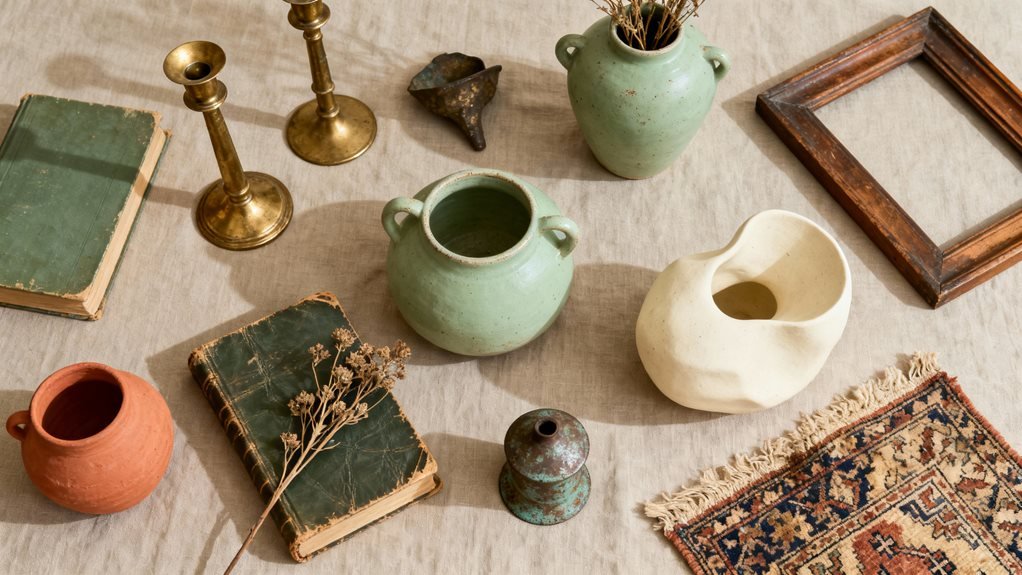
Why do some thrift store shoppers walk out with cohesive, gallery-worthy finds while others end up with a hodgepodge of random items collecting dust? The difference isn’t luck—it’s intentionality.
Before I step into a thrift store, I define my aesthetic boundaries. I ask myself: What colors dominate my space? What era speaks to me? What themes resonate emotionally?
I once bought a gorgeous Victorian mirror simply because it was cheap. It clashed horribly with my mid-century collection and stayed in my closet for months. That mistake taught me to establish non-negotiables.
Create a mood board on your phone. Screenshot pieces you love. Notice patterns: Do you gravitate toward warm woods? Geometric shapes? Botanical prints?
Write down three aesthetic keywords. Mine are “minimal,” “organic,” and “1970s.” These guardrails prevent impulse purchases that’ll sabotage your collection’s cohesion.
Your aesthetic acts as a filter, transforming overwhelming thrift store chaos into focused treasure hunting.
Establish a Unifying Element That Ties Everything Together
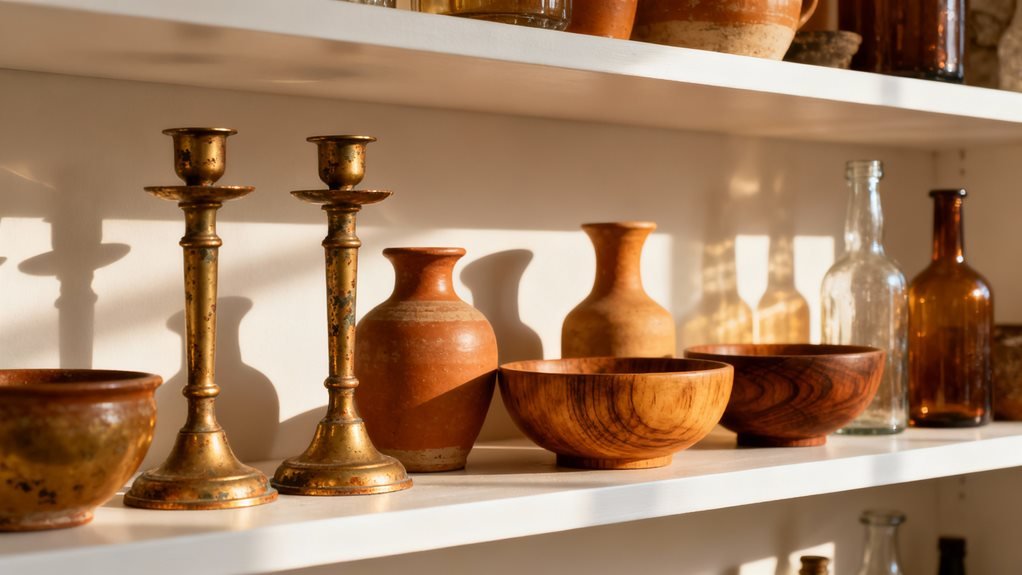
Having clear aesthetic boundaries prepares you for smart shopping, but there’s another layer that separates amateur collectors from skilled curators: the unifying element.
I learned this after buying a dozen pieces I loved individually, only to realize they clashed terribly on my wall. The fix? I identified a common thread—in my case, warm metallic frames—and suddenly everything clicked.
Your unifying element might be a consistent color palette, similar frame styles, or a repeated subject matter. I’ve seen stunning collections bound by texture (all oil paintings), era (mid-century prints), or even negative space (minimalist compositions with breathing room).
Choose one element and stick to it ruthlessly. When I spot a gorgeous piece that doesn’t fit my metallic framework, I walk away. This discipline transforms random finds into an intentional collection.
Test your unifying element by arranging pieces together before purchasing. If something feels off, it probably is.
Master the 80/20 Rule for Visual Balance
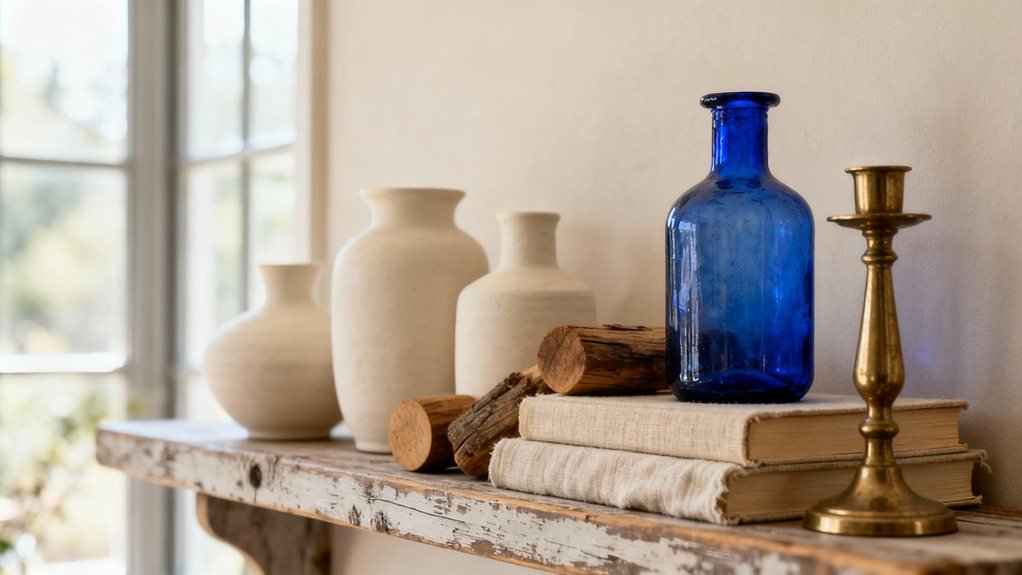
I’ve learned the hard way that filling every surface with thrift store finds creates visual chaos rather than curated charm. The 80/20 rule keeps my spaces balanced: 80% neutral, calming pieces form the foundation, while 20% bold thrift treasures become the stars of the show. This approach starts with identifying your anchor pieces—those substantial items that ground the room—then layering in neutrals before strategically placing your most exciting finds where they’ll make the biggest impact.
Define Your Anchor Pieces
When I started arranging my thrift store finds, I’d enthusiastically cram every quirky piece onto my walls until the space looked like a chaotic yard sale. Everything competed for attention, and nothing stood out.
That’s when I discovered anchor pieces—those standout items that ground your entire collection. I’m talking about your largest, most visually striking finds: an oversized vintage mirror, a bold abstract painting, or an ornate gilded frame.
Start by selecting one or two anchor pieces per wall. Position them first, then build around them with smaller treasures. Your anchors should be roughly three times larger than your supporting pieces.
This hierarchy creates visual breathing room. Now my eclectic collection feels intentional rather than overwhelming, with each anchor piece commanding attention while smaller finds complement rather than compete.
Neutrals as Foundation Layer
My thrift store haul used to look like a kaleidoscope exploded—chartreuse frames next to hot pink ceramics beside turquoise vases. I’ve learned that neutrals create breathing room for your bold pieces to shine. I now follow the 80/20 rule: eighty percent neutrals, twenty percent color.
Start building your foundation with:
- Cream or white ceramic pieces that anchor colorful items
- Natural wood frames that complement rather than compete
- Beige linen textiles providing texture without visual noise
- Black accents adding sophistication and grounding energy
This approach transformed my space from chaotic to curated. Your eye needs rest stops between visual destinations. Neutrals aren’t boring—they’re strategic. They let your treasured colorful finds become intentional focal points rather than competing for attention.
Accent With Bold Finds
Now that you’ve built your neutral foundation, those bold thrift store finds finally have permission to pop. I follow the 80/20 rule religiously—80% neutrals, 20% statement pieces. Last month, I scored a vibrant orange ceramic vase that would’ve clashed terribly in my old setup, but against my beige walls? Pure magic.
| Neutral Base (80%) | Bold Accents (20%) |
|---|---|
| Beige textiles | Jewel-toned ceramics |
| Natural wood frames | Metallic sculptures |
| White ceramics | Colorful artwork |
Start with one bold piece per surface or wall section. I’ve learned that three bright items clustered together read as intentional, while scattered bright pieces create chaos. Test your finds before committing—live with them for a week to ensure they enhance rather than overwhelm your space.
Shop With a Critical Eye and Learn to Leave Things Behind
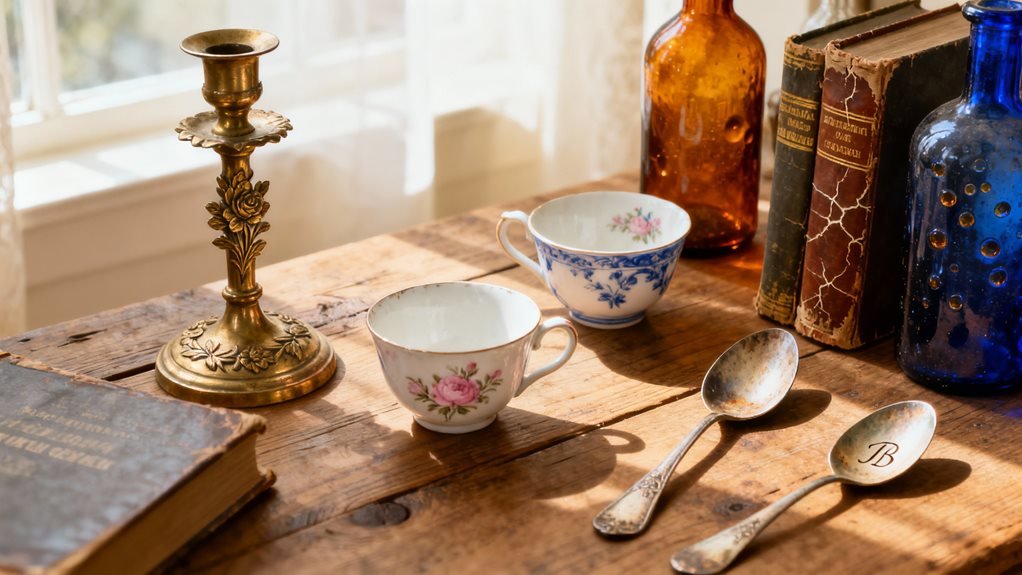
I’ve learned the hard way that thrift store euphoria can lead to a cluttered home full of “almost perfect” pieces that never quite work. Before I refined my approach, I’d grab anything remotely interesting, only to donate half of it six months later because it didn’t match my actual vision. Now I force myself to define what I’m looking for before I shop, and I’ve developed a simple walk-away test: if I’m not genuinely excited about living with a piece for the next five years, I leave it on the shelf.
Know Your Aesthetic Vision
How many times have you walked into a thrift store with good intentions, only to leave with a cart full of items that don’t match anything you own? I’ve been there countless times. Developing your aesthetic vision transforms random shopping into intentional curating.
Before stepping into any thrift store, I define my collection’s direction. Here’s what guides me:
- Color palette – I limit myself to three complementary colors
- Era or style – Mid-century modern, bohemian, or industrial
- Mood – Cozy, minimalist, or maximalist energy
- Function – Decorative pieces, functional art, or conversation starters
This framework prevents impulse buys and creates harmony. When you know your vision, you’ll recognize treasures that enhance your collection rather than cluttering your space.
Practice the Walk-Away Test
The hardest skill I’ve learned as a thrift curator isn’t spotting potential—it’s walking away from it. I used to buy everything that caught my eye, creating a cluttered mess instead of a curated collection.
Now I practice the walk-away test. When something interests me, I continue shopping and circle back twenty minutes later. If I’ve forgotten about it, it wasn’t meant for my collection. If it’s still calling to me, I examine it with fresh eyes.
Ask yourself: Does this genuinely fit my aesthetic vision, or am I just caught up in the thrill of finding something unique? Will it complement what I already own?
This simple practice has saved me money and kept my collection intentional rather than overwhelming.
Create Visual Rhythm Through Repetition and Pattern
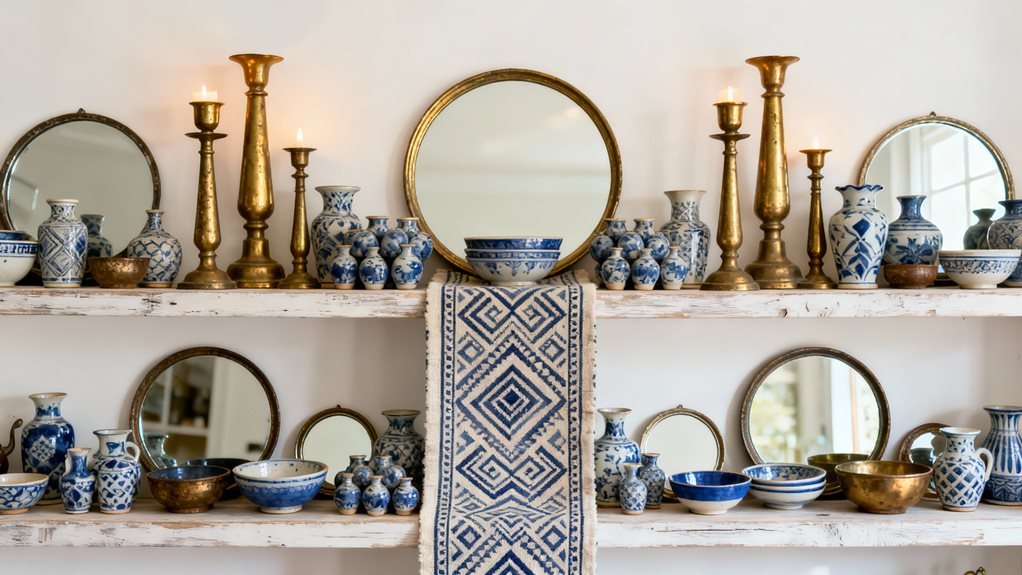
Walking through my favorite thrift store last month, I noticed something magical happening on a vintage shelf display—three ceramic owls of different sizes created this mesmerizing visual pull I couldn’t ignore.
That’s when I understood the power of repetition in curating. You don’t need matching pieces—you need recurring elements that create visual conversation. I’ve learned to hunt for patterns in color, shape, material, or theme.
Here’s what I look for to build rhythm in my collection:
- Recurring colors that appear across different objects (like brass accents threading through various pieces)
- Repeated shapes in varying scales (circular mirrors, round vases, spherical sculptures)
- Material echoes that create texture patterns (wood, ceramic, metal groupings)
- Thematic threads that tie disparate items together (botanical prints, geometric designs, nautical elements)
The secret isn’t identical pieces—it’s intentional repetition that guides your eye naturally through your curated space.
Mix Eras and Styles With Intentional Contrast
Why do my most complimented displays always feature pieces that shouldn’t work together? I’ve learned that intentional contrast creates visual electricity. My Victorian portrait beside a 1970s geometric print generates conversation every time.
The key is creating deliberate tension while maintaining connection through color, scale, or subject matter. Here’s my contrast framework:
| Era Pairing | What Clashes | What Connects |
|---|---|---|
| Victorian + Mid-Century | Ornate vs. minimal | Warm wood tones |
| Art Deco + Rustic | Geometric vs. organic | Bold color accents |
| 80s Abstract + Classical | Chaotic vs. ordered | Similar frame width |
I limit myself to three distinct styles per wall. More feels chaotic rather than curated. When pairing a delicate watercolor with industrial metal art, I’ll echo the watercolor’s blue in the metal piece. This creates what I call “controlled chaos”—unexpected combinations that feel purposeful rather than accidental.
Edit Ruthlessly and Rotate Your Displays Seasonally
How do you know when a display has overstayed its welcome? I’ve learned that if I stop noticing a piece, it’s time for a change. Last spring, I packed away my vintage botanical prints and swapped in bright ceramic finds—suddenly, my living room felt alive again.
Rotating displays keeps your space dynamic and prevents visual fatigue. Here’s my editing process:
- Remove one piece that no longer sparks joy when you walk past it
- Store seasonal items in labeled boxes so you’ll actually remember what you have
- Challenge yourself to create a completely new vignette using three stored pieces
- Donate anything you haven’t displayed in two years (be honest with yourself)
I rotate collections quarterly now, which sounds excessive but actually simplifies decision-making. Winter brings out my moody oil paintings; summer showcases beachy finds. This rhythm transforms curating from overwhelming task into enjoyable ritual.
Frequently Asked Questions
How Do I Clean and Restore Thrift Store Items Without Damaging Them?
I always test cleaning methods on hidden spots first—it’s saved me countless pieces! Here’s a surprising fact: 60% of thrift store damage happens during cleaning, not from age. I start with the gentlest approach: mild soap and water. For wood, I use Murphy’s Oil Soap. On metals, white vinegar works wonders. I avoid harsh chemicals completely. Once, I ruined a vintage lamp by rushing—now I research each material before touching it. Patience pays off!
What’s a Reasonable Budget for Building an Eclectic Thrift Collection?
I’d suggest starting with $20-30 monthly if you’re beginning your collection. That’s what I began with, and it allowed me to snag 3-5 quality pieces each month. As you develop your eye, you’ll spend more strategically. I’ve found setting aside a dedicated “thrift fund” prevents impulse buying and helps you focus on pieces that truly fit your vision. Remember, building a cohesive collection isn’t about spending more—it’s about choosing intentionally.
How Do I Authenticate Valuable Pieces From Regular Thrift Finds?
I’ll authenticate thrift finds by examining maker’s marks, signatures, and construction quality—a skill that’s saved me thousands since experts say up to 15% of thrift store items are genuinely valuable. I research pieces using my phone’s reverse image search right in the store. For potentially significant finds, I’ll photograph hallmarks and consult online collector forums before purchasing. When I’m uncertain about expensive pieces, I invest in professional appraisals—they’ve confirmed several hidden gems in my collection.
Where Are the Best Thrift Stores for Quality Home Decor?
I’ve found the best home decor at upscale consignment shops in affluent neighborhoods and Habitat for Humanity ReStores. Estate sale stores are goldmines too—I once scored a mid-century credenza for $45! Don’t overlook Goodwill locations near wealthy zip codes; they receive incredible donations. Church thrift shops often have vintage pieces at unbeatable prices. My advice? Visit multiple stores regularly since inventory changes constantly, and go on weekdays for first dibs.
Should I Negotiate Prices at Thrift Stores and Estate Sales?
I’ve found that negotiating works better at estate sales than thrift stores. Corporate thrifts rarely budge, but I’ve had success at independent shops when buying multiple items or pointing out damage. At estate sales, I always politely ask, “Is there any flexibility on this price?” especially near closing time. The worst they’ll say is no, and I’ve scored amazing deals by simply asking. Building rapport with sellers helps tremendously.
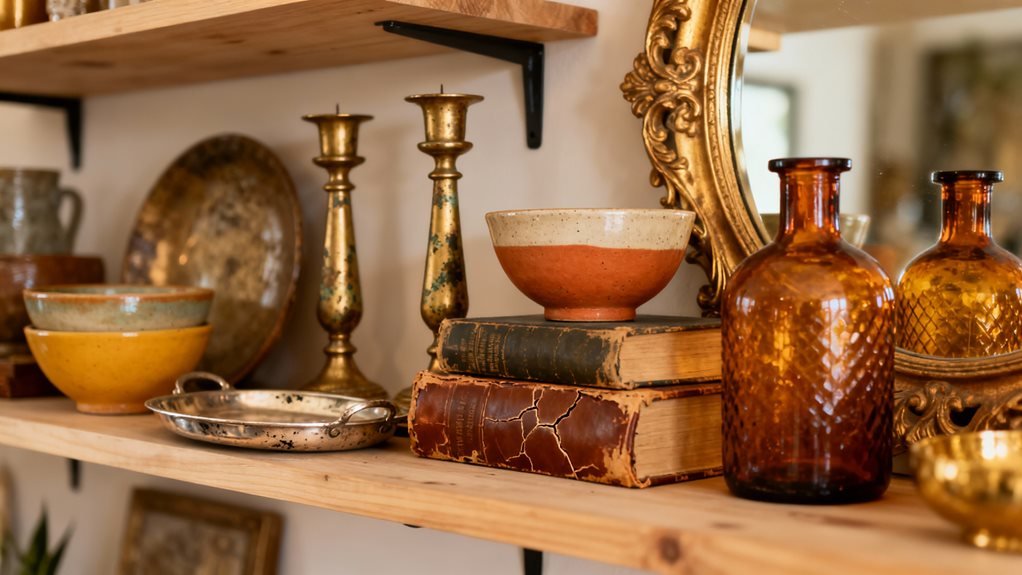
Leave a Reply